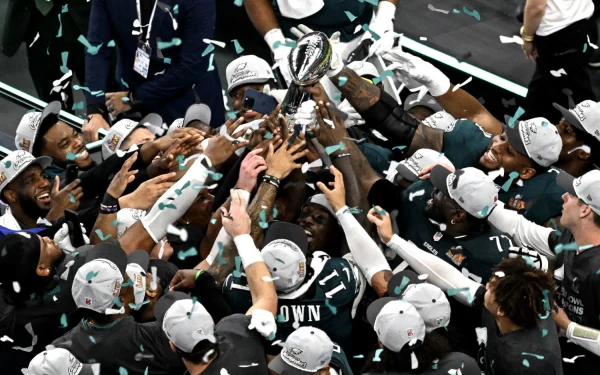This weekend’s Miami Grand Prix highlights will increase the growing popularity of Formula 1 racing in the U.S.
Formula 1 racing, once called “garbage” and “boring” by motorsport analysts, is now the most popular form of motor racing on the planet, with millions of fans worldwide. However, throughout its history, this international success of Formula 1 has never been fully replicated in the United States, but it is slowly becoming one of the prominent sports in the U.S.
“Formula One racing or F1 is the top most level of international single-seater auto or motor racing sport,” says watsonpost.com. “It is a sporting activity governed by the FIA – Fédération Internationale de l’Automobile or the International Automobile Federation, where 10 teams, comprising of two drivers each compete on a series of races over a one-year period or season to determine the ultimate driver and constructor champion.”
Americans have always preferred NASCAR or Indycar over Formula 1, and this is still true, but the recent, rapid, and ongoing rise of Formula 1 could see it ascend to the top amongst most watched motorsports in America.
In 2018, ESPN purchased the streaming rights for Formula 1 in the U.S., and the company has witnessed first-hand how much it has grown. The 2021 Formula 1 season was the most-watched season in American television history with nearly 950,000 viewers per race, a 56 percent increase in viewership compared to previous seasons.
There are multiple reasons for this historic rise of Formula 1 fans in the U.S. Some may look at the increased level of competition in the sport, which last year included the legendary rivalry between Mercedes’ Lewis Hamilton and Red Bull’s Max Verstappen.
Hamilton, the 36-year-old British driver, has dominated the sport for the past decade, winning his fourth straight world championship in 2020 and tying the legend Michael Schumacher for a total record of seven. Looking back at 2021 though, with the emergence of 24-year-old Dutch driver Verstappen, Formula 1 made a complete 180 from what had become to look like a predictable sport.
After 21 intense races, and a couple of crashes between Hamilton and Verstappen, the championship was tied on points and to be decided in the last race, the Abu Dhabi Grand Prix. Hamilton led most of the way, and looked to be set on his way for an eighth world title. For just the fourth time in its 72-year history, a Formula 1 Championship was decided in the final lap of the final race when Verstappen overtook Hamilton en route to his first world title.
The emotional ride of the 2021 season finale is going to go down as one of the greatest races of all time, and once again has contributed to building Formula 1’s fan base. The Abu Dhabi Grand Prix had a worldwide audience of over 107 million fans. To put this into perspective, Super Bowl LVI had an audience of just over 100 million viewers worldwide.
Just in the U.S., there were nearly one million fans tuned in to ESPN2, making it one of the largest American audiences for a Formula 1 Grand Prix. The immense success that ended last season boiled over into this season. With high expectations and a higher audience as well, the first race of 2022, the Bahrain Grand Prix, peaked at 1.5 million viewers on ESPN, becoming the most-watched Grand Prix in America since 1995.
“The first time I watched F1 was last season’s final race. Since then I’ve really enjoyed being more connected and following the sport a little more,” Olympic Heights senior Christopher Santos said, “I also started watching Drive to Survive on Netflix and really became more of a fan of the sport.”
Netflix’s docu-series Drive to Survive, which debuted in March 2019, shows the behind-the-scenes of everything that goes down behind the tracks. Drive to Survive was also a major factor in the record number of new Formula 1 viewers and has helped attract more casual fans to the sport.
Netflix released the fourth season of Drive to Survive this past March. Fans recapped and witnessed more details of everything that went on between Mercedes and Red Bull, with the show highlighting controversies, drama, and competitiveness that took place throughout the season, specifically in the final race. The show also highlights the lives of some Formula 1 drivers.
The documentary was a huge success in the U.S. and took just one day for it to reach Netflix’s Top Ten in the U.S., peaking at #1 worldwide after a couple of weeks. Moreover, the popularity of the series was a direct cause of the rise in young Formula 1 supporters. According to Nielsen Sports, over 75 percent of Formula 1’s audience growth since 2020 has been driven by fans between the ages of 16 and 35.
The expanding American Formula 1 fan base hasn’t gone unnoticed by the international association for motor racing, or FIA as abbreviated in Italian. With the Formula 1 market as high as it has ever been in the U.S., the FIA is seizing the opportunity to expand its popularity in what has the potential to be one of the biggest Formula 1 markets in the world.
Starting in 2023, the U.S. will be the only country to host three Grand Prixs throughout a single season. The U.S. already hosts the Austin Grand Prix and this Sunday, May 8, it will see the inaugural race of the Miami Grand Prix, which will take place around the Miami Dolphins’ very own Hard Rock Stadium. In addition, the 2023 Formula 1 season is set to include the return of the Las Vegas Grand Prix. Coming in November 2023, the Las Vegas Grand Prix will see drivers race along the city’s famous Strip on Thanksgiving weekend.
“40 years after its last Grand Prix, Las Vegas is back in F1!” tweeted FIA President Mohammed Ben Sulayem. “I welcome this good news for the development of motor sport in the USA and the Americas.”
The U.S.’s F1 history, although not at the same level as some European countries, isn’t to be dismissed. The U.S. has two former Driver’s World Champions in Phil Hill and Mario Andretti. They both won titles in 1961 and 1978, respectively.
The 44-year title drought for the U.S. doesn’t seem like it will end anytime soon. The last American to compete in Formula 1 is Alexander Rossi in 2015. Formula 1 is a business, and it certainly isn’t a simple one to get in to, especially for American drivers who already have other motorsports alternatives in their native country. Most Formula 1 drivers come from European junior karting leagues, and sponsors hardly ever provide U.S. drivers with funding overseas.
The idea of an American driver in Formula 1 remains challenging, but it definitely isn’t ruled out. Formula 1 motorsports team Haas is the only American-owned team, run by NASCAR founder Gene Haas. Since purchasing the team in 2016, the world has yet to see an American race for Haas, but with the U.S. Formula 1 market growing, fans can still hope.
Another opportunity for Americans could be opened through Michael Andretti, son of former American F1 champion, Mario Andretti. Back in February, Michael Andretti announced he, along with his racing organization, Andretti Autosports, has launched a bid to create a Formula 1 team by 2024. Andretti has emphasized one of his goals is to sign an American driver.
The two most probable candidates for a future Formula 1 seat are Colton Herta and Logan Sargeant. The 22-year-old California native, Herta currently races in the NTT IndyCar, and is the youngest person to ever win an IndyCar Series race. Herta has also signed as a testing driver for Formula 1’s British team, McLaren. Meanwhile, 21-year-old Florida native, Sargeant has taken a more common route and currently races in Formula 2, and is a member of the Williams Driver Academy.
With the growth of the Formula 1 market in the U.S., it is inevitable that there will soon be an American driving through the Formula 1 track. It has become a matter of “when,” not “if.” When this happens, it will only contribute to the expansion of Formula 1’s popularity throughout the country as it will give fans someone to cheer for, and many believe this could be the final piece of the puzzle for Formula 1 to become a major sport in the U.S.











